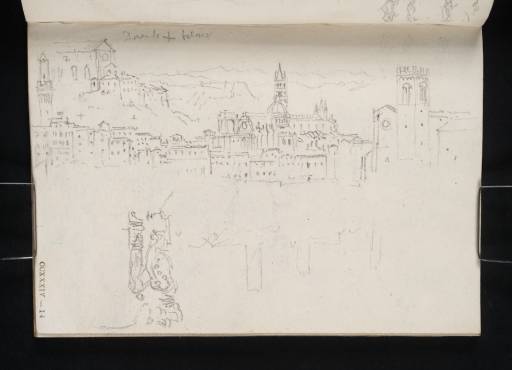Joseph Mallord William Turner The Cathedral of Santa Maria Assunta and the Basilica of San Domenico, Siena; a Medici Heraldic Shield on the Porta Camollia 1828
Image 1 of 2
-
 Joseph Mallord William Turner, The Cathedral of Santa Maria Assunta and the Basilica of San Domenico, Siena; a Medici Heraldic Shield on the Porta Camollia 1828
Joseph Mallord William Turner, The Cathedral of Santa Maria Assunta and the Basilica of San Domenico, Siena; a Medici Heraldic Shield on the Porta Camollia 1828 -
 Joseph Mallord William Turner, The Cathedral of Santa Maria Assunta and the Basilica of San Domenico, Siena; a Medici Heraldic Shield on the Porta Camollia 1828 (Enhanced image)Enhanced image
Joseph Mallord William Turner, The Cathedral of Santa Maria Assunta and the Basilica of San Domenico, Siena; a Medici Heraldic Shield on the Porta Camollia 1828 (Enhanced image)Enhanced image
Joseph Mallord William Turner,
The Cathedral of Santa Maria Assunta and the Basilica of San Domenico, Siena; a Medici Heraldic Shield on the Porta Camollia
1828
Folio 14 Recto:
The Cathedral of Santa Maria Assunta and the Basilica of San Domenico, Siena; a Medici Heraldic Shield on the Porta Camollia 1828
D21614
Turner Bequest CCXXXIV 14
Turner Bequest CCXXXIV 14
Pencil on paper, 104 x 148 mm
Inscribed in pencil by Turner ‘D[?omenico] + [...]’ towards top left and ‘2’ towards top left
Stamped in black ‘CCXXXIV – 14’ bottom left, descending vertically
Inscribed in pencil by Turner ‘D[?omenico] + [...]’ towards top left and ‘2’ towards top left
Stamped in black ‘CCXXXIV – 14’ bottom left, descending vertically
Accepted by the nation as part of the Turner Bequest 1856
References
1909
A.J. Finberg, A Complete Inventory of the Drawings of the Turner Bequest, London 1909, vol.II, p.718, CCXXXIV 14, as ‘View of Sienna’.
Dominating this panoramic view of Siena is a detailed study of the city’s Cathedral of Santa Maria Assunta, constructed during the thirteenth century in a blend of Romanesque and Gothic styles. To the right is the ornate entrance façade, which faces south-west, and the dome and belltower are visible at the centre of the building. The vista terminates to the far left with the Torre del Mangia, a fourteenth-century civic tower that rivals the cathedral belltower in height. It overlooks the city’s main square, the Piazza del Campo, and lies adjacent to the town hall, the Palazzo Pubblico; see folio 15 recto (D21616) for a more detailed rendering.
In the right foreground is the Basilica of San Domenico, distinguished by its crenellated tower. The hilltop building in the top-left corner, labelled ‘2’, is part of the same basilica. For further views of this subject, see folios 15 verso, 16 recto and 17 recto (D21617–D21618, D21620). Turner’s elevated vantage point for this composition is from in front of the basilica, looking south-east.
In the lower half of the page, inverted relative to the view above, is a silhouetted skyline with three towers. To the left is a separate study of the Medici heraldic shield flanked by a sculptural figure. This is likely a detail from the Porta Camollia, one of Siena’s principal gateways. Historically, it guarded the northern part of the city and served as the main point of entry from Florence to the north, especially for pilgrims travelling along the Cassia Way.1 The original thirteenth-century gate was destroyed by the Medici army during the Siege of Siena in 1555, and the shield sketched here is an addition from 1604, marking the victorious entry to the city of Ferdinand I de’ Medici, Grand Duke of Tuscany.2 See folio 13 recto (D21612) for a more distant outline of the Porta Camollia.
For further commentary on Turner’s first visit to Siena in 1828, together with a list of relevant works in the sketchbook, see under folio 10 verso (D21607).
Hannah Kaspar
November 2024
‘Porta Camollia gate and Fortino delle donne fort’, Visit Siena, accessed 24 June 2024, https://visitsienaofficial.it/en/porta-camollia-gate-and-fortino-delle-donne-fort/ .
How to cite
Hannah Kaspar, ‘The Cathedral of Santa Maria Assunta and the Basilica of San Domenico, Siena; a Medici Heraldic Shield on the Porta Camollia 1828’, catalogue entry, November 2024, in David Blayney Brown (ed.), J.M.W. Turner: Sketchbooks, Drawings and Watercolours, Tate Research Publication, February 2025, https://www

